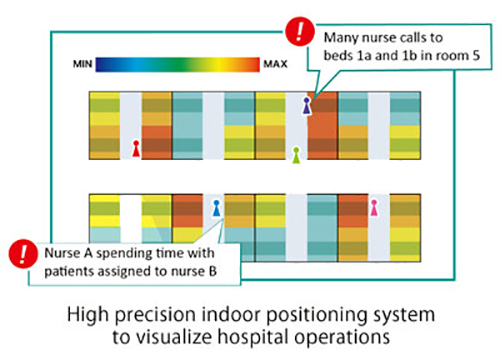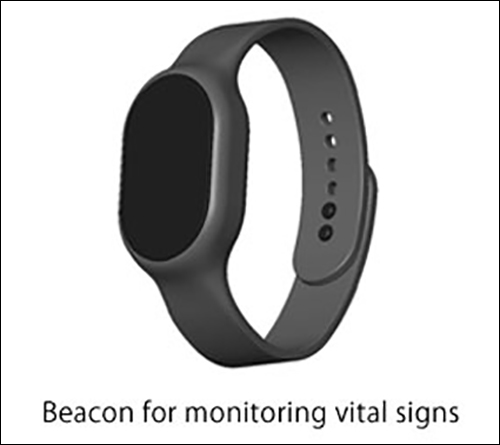Japan’s Nagoya University Hospital has launched a smart hospital proof-of-concept (PoC) at its Medical IT Center that uses Bluetooth Low Energy (BLE) to capture patients’ vital signs and locations, as well as the movements of staff members. The solution is provided by technology company SATO Healthcare. Testing began this month and is expected to continue throughout the year.
The hospital, established in 1871, contains more than 1,000 beds and serves 573,400 outpatients annually. The facility has been growing, and recently began investigating multiple technology solutions to help it provide the best possible patient treatment as it expands. For example, it has launched a night-time robot to transport medications to departments where they are needed, and has researched ways in which Internet of Things (IoT) technologies can be used to better understand what is happening with patients, assets and personnel.

The smart hospital pilot employs SATO Healthcare’s BLE beacons for two purposes, says Shintaro Oyama, the lead principal investigator and researcher at Nagoya University Hospital’s Medical IT Center. The first is to track the locations of staff members and thereby understand where they go, as well as how often and for how long they interact with patients. The other objective is to capture a patient’s vital signs, and to then transmit those measurements to be stored along with his or her identity and location. The technology not only tracks where patients and employees are located, but how long they are together. The PoC aims to determine how well the technology can measure nurses’ responses to patient needs and the subsequent treatment those patients receive.
The hospital is using a Hosiden MEDiTAG sensor-based BLE beacon wristband for collecting and transmitting patients’ vital signs. The hospital seeks to measure the point at which staff members may need more support to properly serve patients. Until now, information regarding staffing and workloads was largely anecdotal. “Previously, hospital workers have mentioned the difficulty of their work,” Oyama says, “but it has not been quantitatively measured. By making quantitative measurement possible, we hope to efficiently optimize service.”
Nagoya has looked into a variety of solutions to measure patient care and staff workloads. “When we initiated this study,” Oyama recalls, “the level of precision necessary was unclear.” The hospital considered using Wi-Fi- or magnetic detection-based systems, but felt that it required the location precision that BLE technology offers. “We believe that the location detection accuracy with this system will be a benchmark for us as we move forward, which is why we selected the SATO system.”
SATO Healthcare’s indoor location system tracks the locations of hospital workers as they go about their jobs. Beacon devices track each patient’s vital signs, including his or her heart rate, physical movement and stress level, among other details. It can capture location data to the level of a hospital bed.
The MEDiTAG device became commercially available for the Japanese market in December 2017, according to Hiroyuki Konuma, SATO Healthcare’s president. SATO determined that the MEDiTAG, as well as the off-the-shelf beacon device used for staff members, would provide the necessary location granularity that the hospital required. The pilot consists of approximately 130 MEDiTAG beacon devices to track both vital signs and location data.
Both types of beacon devices transmit data to fixed beacon receivers installed in the ceilings of hospital rooms (one per room). The software further identifies an individual’s location down to the bed level, Konuma adds, by employing angle of arrival (AoA) triangulation rather than signal strength, due to AoA’s higher level of precision.
Once a patient is assigned a wristband, the sensors begin collecting vital sign measurements, which are then transmitted to gateway readers via BLE, along with the wristband’s unique ID number. Those gateways capture the data and forward it to third-party software, hosted on the cloud. The patient’s own identity is not stored with the wristband ID.

If a patient’s vital signs become a concern, such as a rapid change in heartbeat rate, the software will display an alert for the hospital staff on the monitor at the nurse’s station. In the future, the facility might opt to send alert data directly to nurse call terminals or smart devices carried by employees, in order to get alerts more immediately in front of those who should respond.
The staff members currently carry their own beacons, inserted into nurse-card holders. In the future, however, SATO plans to equip staff members with modified MEDiTAG beacons. As employees move around the facility, each individual’s location is monitored, as well as the patients with whom he or she meets, and for how long.
If the proof-of-concept proves to be successful, the hospital plans to consider a permanent installation. SATO Healthcare may also commercialize the solution for other hospitals in Japan and abroad. For Nagoya University Hospital, beyond the there are multiple options for the technology use beyond the PoC.
“I see three possibilities,” Oyama says. In one scenario, the hospital could deploy the technology within other facility wings, in order to ensure optimized staffing levels during busy shifts. The facility could also use the platform as a testbed for new ICT or IoT health-care devices. Finally, Oyama adds, the technology could be configured with the minimal number of antennas and deployment size to enable it to be easily deployed at other hospitals.

